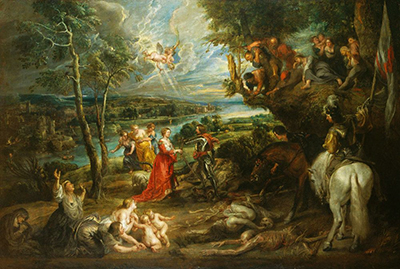Landscape with St George and the Dragon was painted by Peter Paul Rubens between 1630 to 1635. Rubens served as a Flemish diplomat in England in 1629-30 and seems to have formed a genuine fondness for the country and its rural scenery.
Rubens produced the centrepiece of the painting while in England, taking it home with him when he left, almost as a souvenir of his visit. In 1635 the painting in its now completed and enlarged form was acquired by King Charles I and formed part of the collection at Windsor Castle.
The painting has St George front and central, standing over the defeated dragon. When first painted, St George and the woman he addresses would have dominated the canvas, but Rubens added to the edges of the painting in the years before it returned to England. Indeed, the joins in the canvas can be spotted by the naked eye.
The final painting is an elaborate scene fitting of the baroque style Rubens was known for. The flag of St. George is held by a mounted horseman and widows mourn husbands killed by the dragon, all while two angels swoop gracefully overhead.
Although the image of St. George is too alike King Charles I to probably be coincidence, the woman he is with is not a likeness of the King’s wife, Queen Henrietta Mary. For all its grandeur of symbolic imagery the painting is more a homage to the country than the King. While in London Rubens stayed at York House in London and this painting could well be his view of the river Thames from this residence.
It was not the first occasion Rubens had incorporated St George in a painting. Around 1605 Rubens painted St George and the Dragon in a more symbolic portrayal, including a girl holding a lamb representing the purity of the church.
Rubens was one of the most influential painters of baroque art, using colour and grandeur to present images in all their dramatic glory. He was inspired by Italian masters such as Caraveggio, Titian and Veronese. Yet his own legacy was to influence many of his peers and artists across the years. Manet, Van Gogh, Picasso and Rembrandt have all been influenced by Rubens work, as have the landscapes of Constable and Gainsborough.
Peter Paul Rubens was a diplomat whose exceptional artistic talent was recognised and trusted at the royal courts of Europe. In Landscape with St George and the Dragon though, he simply seemed to want a painting of a place for which he had grown fond.




